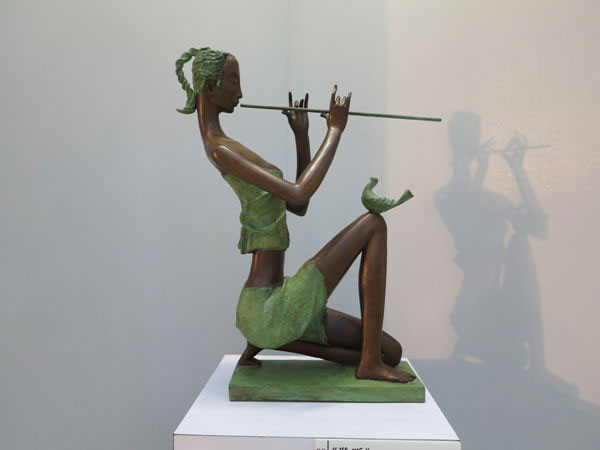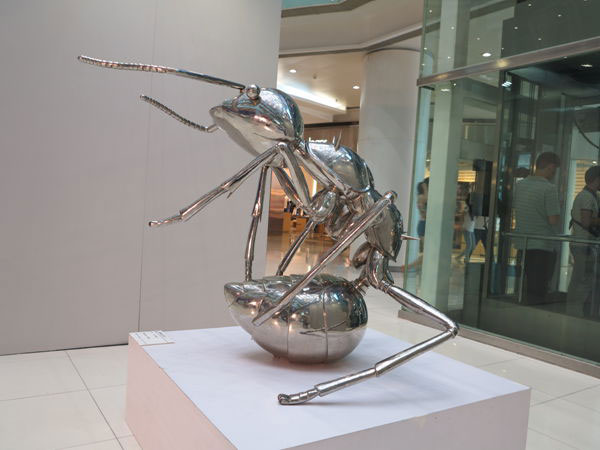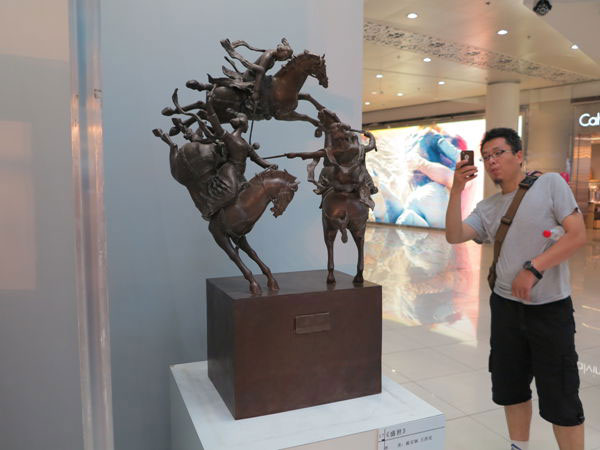
The sculpture exhibition at Viva--Beijing R&F Plaza, 北京富力广场 Title of the work: Deep Listening (聆听) Artist: Zhang Hua (章华) Photo: Sino-US.com by Rebecca Lin
Some art lovers say they prefer town life to country life because they get to enjoy art exhibitions more in the cities. That’s especially true of China and, what’s more, you don’t need to go to the museums or galleries to enjoy art. You can just go shopping, as some high-end stores and shopping malls in big cities like Beijing and Shanghai also put on art exhibitions periodically.
Attentive shoppers are pleasantly surprised to see elegant or exotic artworks displayed in obscure corners of big shopping malls. “We hope to create a cozy and elegant ambience, so that our guests can hang around and then buy more things,” Louis Liu, a manager from a high-end store in Beijing, told the reporter of Sino-US.com.
Art exhibitions are burgeoning in big shopping malls and high-end stores, like the Sanlitun Village (三里屯Village 北区) and UA town (合艺街) inside The Place (世贸天阶).
The Sanlitun Village, a landmark shopping building in Sanlitun, a popular hangout for expats, specially opened an entire floor for art galleries. According to the management of the Sanlitun Village, this is definitely a bold trial and they are learning from successful foreign practices. The new setup is apparently designed to attract more international fans.
In 2011, The Place (世贸天阶), a trendy shopping mall in Beijing’s CBD area, opened UA Town (合艺街), the biggest cultural square in China covering an area of nearly 1,400 square meters. According to Li Yi, one managerial staff of the mall, given the presence of a middle-class with high consumption power in the neighborhood, the mall believes their customers would be more willing to appreciate art. “So, we’ve brought art houses in and formed a new mode of cooperation to satisfy the demand. UA Town aims to bring art into life for our visitors,” said Li Yi.
And besides downtown and CBD, some residential areas are also trying to hold art exhibitions for the benefit of the residents in the neighborhood.

The sculpture exhibition at Viva--Beijing R&F Plaza, 北京富力广场 Title of the work: Ant Baby (蚂蚁宝贝) Artist: Chen Zhiguang (陈志光) Photo: Sino-US.com by Rebecca Lin
Viva (also named Beijing R&F Plaza, 北京富力广场), a landmark shopping mall in Shuangjing (双井), recently held an impressive sculpture art exhibit with the help of a well-known magazine “Sculpture 雕塑”.
“From the start, we had the atrium of Viva designed for exhibiting artworks or doing fashion shows. As far as I’m concerned, it is a trend that almost all the big malls in Beijing are now following,” said Louis Liu, vice general manager of R&F Group’s Commercial Operating Center.
Liu said, “We first brainstorm and get the ideas, like what kind of artistic themes we’d like to present to our customers. And then we try to contact all the related organizations or individuals. Artists usually feel happy for their works to be known and admired by more people and that’s the reason why the marriage of art and commercial pursuits could truly go well.”
Commenting on the trend of the fusion of commerce with art, an industry insider said the reason may be because shoppers are changing. “In the past, they just needed to buy things; now, they live to shop - the act of shopping itself has become some kind of a pleasant life experience.”

The sculpture exhibition at Viva--Beijing R&F Plaza, 北京富力广场 Title of the work: A Prospering World (盛世) Artist: Ling Baogang (蔺宝钢), Wang Hongliang (王洪亮) Photo: Sino-US.com by Rebecca Lin
The annual per capita GDP of Beijing residents surpassed $10,000 dollars in 2009. Lai Yang, general secretary of Beijing Institute for Commercial Economy, said that along with the rising incomes, the consumption mode in the city has also changed and more and more people are trying to seek pleasure and relaxation.
“Now, they do not just need useful things of high quality—they need commodities that could testify to their taste or show off their status. Our lifestyle has changed,” said Lai.
“I find the art works here quite attractive, so I take pictures and upload them to my Weibo (China’s micro-blogging service),” Guan Yang, a student from Beijing University of Technology, told the sino-us.com, while shopping in Viva together with his girlfriend.
And Zheng Xiaoqin, a white-collar worker from the neighborhood, who was busy taking pictures, said, “I usually would not go to the museums or galleries during weekends, but I find these artworks enticing and they make me feel relaxed, so maybe I will go to the museums more in the future.”
Wang Zhong (王中), a professor from the China Central Academy of Fine Arts, believes the new trend started by the commercial centers is positive and could achieve a win-win result. “Culture is the heart and soul of a city. Even if the stores only aim to promote shopping ambience for gaining more revenue, their efforts at the same time provide residents a valuable touch of enlightening culture and art.
And more and more white collar workers are being drawn to these places, just because they feel artworks displayed in such venues seem not that hard-nosed and thus strike quite a familiarity.
According to Lai Yang, in the near future, comprehensive shopping malls including supermarket, store and recreational center would take on more functions that facilitate visitors to shop, socialize and entertain themselves: like the Giant Eagle in the US that changes the supermarket into a Disney, or the Gold Café that transforms banks into coffee shop, or Beijing’s Da Dong Roasted Duck that presents every dish as an artwork, or Hong Kong’s K11 that remodels shopping mall into an artistic center—big malls would gradually be turned into leisure destinations that are more characteristic, artistic, entertaining and at the same time memorable.
 |
| Touched | Sympathetic | Bored | Angry | Amused | Sad | Happy | No comment |
Rhythm Media Group is a multi-media company, operating a US-based Chinese daily newspaper, The China Press, and the paper's website - uschinapress.com (which has mobile-app version), as well as a Beijing-based English website Sino-US.com. The group boasts 15 branch offices across the US, and a number of cultural centers focusing on culture-related business in the North America, Chinese mainland, Hong Kong and Taiwan.Launched in September 2012, the Sino-US.com is designed to serve as a bridge between China and the US, and to keep its readership inside or outside China better informed by providing news and insights on China's current affairs, culture, life, business, people and sports.
|
|